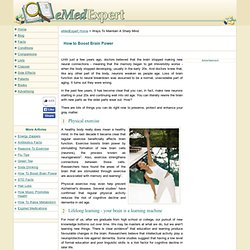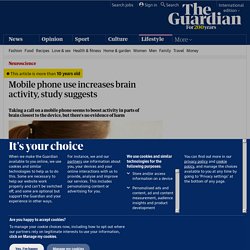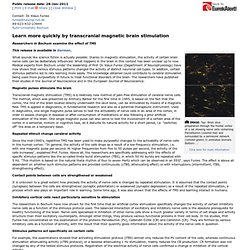

Maps: Brain Storm.mmap. BrainHacks. How To Boost Brain Power and Memory. Until just a few years ago, doctors believed that the brain stopped making new neural connections - meaning that the memory began to get irreversibly worse - when the body stopped developing, usually in the early 20s.

And doctors knew that, like any other part of the body, neurons weaken as people age. Loss of brain function due to neural breakdown was assumed to be a normal, unavoidable part of aging. It turns out they were wrong. In the past few years, it has become clear that you can, in fact, make new neurons starting in your 20s and continuing well into old age. You can literally rewire the brain with new parts as the older parts wear out. There are lots of things you can do right now to preserve, protect and enhance your gray matter. 1Physical exercise A healthy body really does mean a healthy mind. Physical exercise may even help prevent Alzheimer's disease. Www.rickhanson.net/wp-content/files/SlidesNeuroplasticity.pdf.
Neuroplasticity. Contrary to conventional thought as expressed in this diagram, brain functions are not confined to certain fixed locations.

Neuroplasticity, also known as brain plasticity, is an umbrella term that encompasses both synaptic plasticity and non-synaptic plasticity—it refers to changes in neural pathways and synapses which are due to changes in behavior, environment and neural processes, as well as changes resulting from bodily injury.[1] Neuroplasticity has replaced the formerly-held position that the brain is a physiologically static organ, and explores how - and in which ways - the brain changes throughout life.[2] Neuroplasticity occurs on a variety of levels, ranging from cellular changes due to learning, to large-scale changes involved in cortical remapping in response to injury.
The role of neuroplasticity is widely recognized in healthy development, learning, memory, and recovery from brain damage. Kinesthetic learning. Kinesthetic learning (also known as Tactile learning) is a learning style in which learning takes place by the student carrying out a physical activity, rather than listening to a lecture or watching a demonstration.

People with a preference for kinesthetic learning are also commonly known as "do-ers". Tactile-kinesthetic learners make up about five percent of the population.[1] The Fleming VAK/VARK model (one of the most common and widely used categorizations of the various types of learning styles)[2] categorized learning styles as follows: History[edit] Kinesthetic intelligence was originally coupled with tactile abilities, and was defined and discussed in Howard Gardner's Frames Of Mind: The Theory of Multiple Intelligences.
In his book, Gardner describes activities (such as dancing and performing surgery) as requiring great kinesthetic intelligence: using the body to create (or do) something. Characteristics[edit] Eidetic memory -photographic memory. Overview[edit] The ability to recall images in great detail for several minutes is found in early childhood (between 2% and 10% of that age group) and is unconnected with the person's intelligence level.

[citation needed] Like other memories, they are often subject to unintended alterations. The ability usually begins to fade after the age of six years, perhaps as growing vocal skills alter the memory process.[2][3] A few adults have had phenomenal memories (not necessarily of images), but their abilities are also unconnected with their intelligence levels and tend to be highly specialized. Neuroscience, free will and determinism: 'I'm just a machine'.
What does this mean in terms of free will?

"We don't have free will, in the spiritual sense. What you're seeing is the last output stage of a machine. There are lots of things that happen before this stage – plans, goals, learning – and those are the reasons we do more interesting things than just waggle fingers. But there's no ghost in the machine. " The conclusions are shocking: if we are part of the universe, and obey its laws, it's hard to see where free will comes into it. "If you see a light go green, it may mean press the accelerator; but there are lots of situations where it doesn't mean that: if the car in front hasn't moved, for example. Slowly, however, we are learning more about the details of that complexity.
Berkeley on Biphasic Sleep. If you see a student dozing in the library or a co-worker catching 40 winks in her cubicle, don’t roll your eyes.

New research from the University of California, Berkeley, shows that an hour’s nap can dramatically boost and restore your brain power. Indeed, the findings suggest that a biphasic sleep schedule not only refreshes the mind, but can make you smarter. The lost art of total recall. A few middle-aged couples are chatting at a dinner party when one husband, Harry, starts talking enthusiastically about a new restaurant he has just visited with his wife.

What's its name, demands a friend. Harry looks blank. There is an awkward pause. Mobile phone use increases brain activity, study suggests. Radio waves from mobile phones appear to boost activity in parts of the brain that are closest to the devices' antennas, according to US government scientists.

Researchers found that a 50-minute call led to a localised increase in brain activity of 7%, but they said there was no evidence to suggest the rise was harmful. To rule out the variation in brain activity that would be expected when someone listens to a call normally, changes in activity were monitored while the phone was taking a call but was muted. The team, led by Nora Volkow, director of the National Institute on Drug Abuse in Maryland, found that brain activity rose in line with the strength of the electromagnetic field to which the particular brain region was exposed. Mobile phones use radio waves to send and receive calls and these produce small electromagnetic fields that can be absorbed by the head and brain.
In the new study, 47 volunteers were given two brain scans, each on different days. Brain wave function. Learn more quickly by transcranial magnetic brain stimulation. Public release date: 28-Jan-2011 [ Print | E-mail Share ] [ Close Window ] Contact: Dr.

Klaus Funkefunke@neurop.rub.de 49-023-432-23944Ruhr-University Bochum This release is available in German. What sounds like science fiction is actually possible: thanks to magnetic stimulation, the activity of certain brain nerve cells can be deliberately influenced. Magnetic pulses stimulate the brain. Little-known growth factor enhances memory, prevents forgetting in rats.
50 Ways To Boost Your Brain Power.